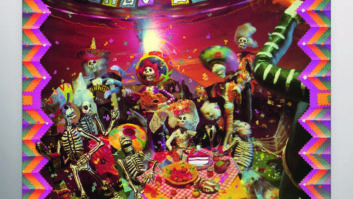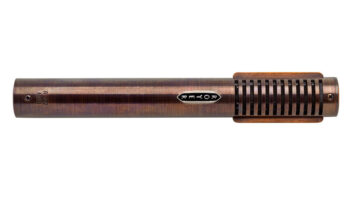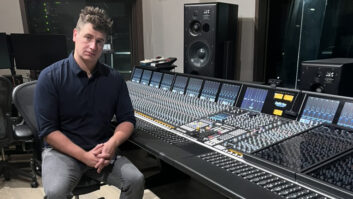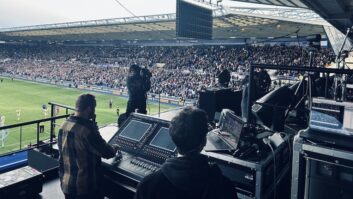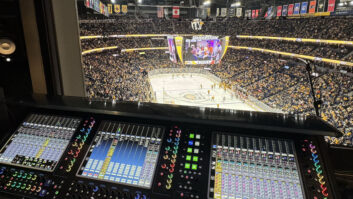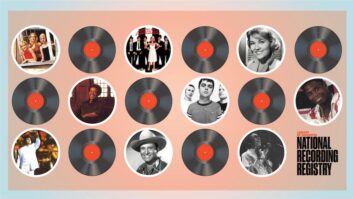It’s never been easy to get a handle on Los Lobos. On the surface, they seem like a band that mixes good-time rock ‘n’ roll with festive Mexican tunes; try as they might, they’ll never completely escape “La Bamba.” But as their large and devoted following knows, they’ve always been much more than that. Guitarist/singer David Hidalgo and drummer/lyricist Louie Perez have evolved into one of rock’s most interesting songwriting partnerships, with a catalog of tunes that range from impressionistic portraits and contemplative musings about fate, faith and death, to cryptic, dream-like sound poems. And guitarist/singer Cesar Rosas has carved out a niche of his own with his songs: rough-and-tumble rockers, charged R&B, and those spry Mexican waltzes and polkas. Live, the two guitarists can kick up a squall worthy of the heaviest metal band, yet it’s never too long a wait for the next delicate Hidalgo ballad. They also have quite a repertoire of cover tunes, which they render with tremendous authority and personality: songs such as Traffic’s “Dear Mr. Fantasy” and “40,000 Headmen,” the Grateful Dead’s “Bertha,” Neil Young’s “Cinnamon Girl” and “Down by the River,” Bob Marley’s “Exodus,” Jimi Hendrix’s “Are You Experienced” and “Spanish Castle Magic,” and Fleetwood Mac’s “Oh Well.”
This is a band that has never been afraid to take chances, especially on their albums, which have been unfailingly adventurous since their landmark Kiko CD in 1992. That album marked the first full-length collaboration between the band and the producer/engineer team of Mitchell Froom and Tchad Blake. Together, they have made four Los Lobos albums, and Hidalgo, Perez, Froom and Blake have also made a pair of thoroughly bizarre CDs as the Latin Playboys. That partnership was marked by plenty of sonic experimentation and unusual instrumental arrangements; more often than not, they hit the mark, but they also alienated some of their longtime fans in the process. Can you squash one too many vocals, with odd compression? Maybe.
Los Lobos’ latest CD, Good Morning Aztlan, takes a slightly more straightforward approach than their last couple of albums; not coincidentally, it was made without Froom and Blake onboard. This time it was helmed by British producer/engineer John Leckie (XTC, Stone Roses, Radiohead, The Verve), with additional engineering by longtime Los Lobos associate Dave McNair. (He recorded the two Los Super Seven projects, featuring Hidalgo and Rosas and produced by Lobos reedsman Steve Berlin.) The result is stunning: The band’s eclecticism is still very apparent, and clearly there is still some Blake/Froom influence (McNair was partly schooled by Blake). But there’s a power and passion to the performances that feels new, more akin to the way the band sounds live. Whether or not this CD betters the group’s commercial stature, which has been in decline for some time, is anybody’s guess — they’re probably still too cool for most radio stations — they’ve made an album that easily stands with their best. If there was any justice in this world, the incredibly catchy title track and the sultry, Curtis Mayfield/Marvin Gaye-influenced song “The Word” would be enormous hits.
“We spent about 10 years with Froom and Blake, and I wouldn’t trade a second of it,” says Steve Berlin. “I love the records we made together. But it was time to do something new. We have a new label, and we wanted to approach this album in a different way. In no way would I ever disparage Mitchell and Tchad’s work, but it had become almost too comfortable working with them. We’d gotten to a place where we didn’t have to work very hard, frankly. They covered so much ground and were able to make any idea sound brilliant, even if it was a crappy idea. And I mean that with all the love in the world. But to a certain extent, working with John [Leckie] revealed how much we counted on Mitchell and Tchad to cover many, many bases and to do some of the work that we probably should do as a band.”
Leckie says he has known Blake for quite awhile and thinks very highly of him: “He works here at Real World [Peter Gabriel’s studio in England] a bit, and I’ve met him a few times there. So I told Tchad I’d been asked to do Los Lobos, and he said, ‘I’m not surprised. They’re always talking about you.’ They said they liked the Radiohead record I did [The Bends]. But David Hidalgo also said he really likes The Dukes of Stratosphear [the psychedelic alter-ego of XTC]. He said, ‘That’s what we’re going for.’ I thought, ‘Oh Christ! What am I getting into?’” he laughs.
Neo-psychedelic Los Lobos? “Well, that’s a bit like what we’ve ended up with, actually,” Leckie says. “Each track is quite different from the others; each one stands on its own. It’s not a live record at all; it’s not like the live band playing. In fact, they’re a bit reluctant in the studio to all get together. I had this dream that they’d all be there and we’d do three tracks a day and they’d all be sitting there playing. But it turns out they like doing things one at a time!” And he laughs again. That said, the album sounds like a band playing together.
Good Morning Aztlan was recorded at Cesar Rosas’ home studio east of L.A. Four or five tracks had already been recorded by Dave McNair when Leckie was brought in late last fall. “We were there for about five weeks on and off,” Leckie says. “He’s got a really large house near Roland Heights. And they all live within 10 minutes of each other. The studio worked fine, really. It was a studio that’s been kind of lashed together, but everything worked, and it’s a large enough space. There’s a drum booth, and we put the amps in another room.
“He’s a got a nice broadcast Neve desk in there with 36 inputs. All the channels are there; they’re all working. I think it’s got 33129 modules. He’s got an MCI 2-inch 24-track; one of the last ones made by Sony. He’s also got an Ampex 16-track, which we never fired up. No Pro Tools.”
“There were a couple of times when things stopped working, and that was frustrating for John,” Berlin says, “but it ended up being a good place to record. Any time you work in a home studio, things are going to come up: We’re all ready to go and someone has to take the gerbil to the vet; that was a little annoying,” he says with a chuckle. “But it was very comfortable for Cesar, which was important.” (Rosas has been raising his children alone since his wife’s death a couple of years ago.)
Berlin says that Leckie was a good choice for the album because he’s an “extremely normal, patient and even-keeled guy, which is a big part of the job, because we tend to be pretty hard to corral. It’s hard to get everyone in the room, hard to get everyone pulling on the same side of the rope, hard to get everyone focused on the same thing at the same time. No one is obstinate or trying to hog the spotlight or any of that. But we’re like kittens in a respect — a little piece of dust flies through the air and we’ll chase it around the house for an hour! We’ll go out on a [musical] tangent without much urging.
“What we realized early in the process is that John being John — and not Mitchell and Tchad — is the kind of guy who said, ‘This is your record; you do it. You figure it out. You play the parts; I’ll make it sound as good as I can.’ And, at first, that was a bit of a shock, but everyone snapped to it pretty quickly. We had to work a little harder and maybe even play a little better, which is a good thing. I think some of the performances on this record are among the best we’ve ever done.”
The songs fell together in an assortment of ways. Typically, Cesar Rosas’ tunes came in fully demo’d, with him playing all the instruments, “and Dave [Hidalgo] would bring in these scrappy guitar-and-voice versions of songs; they wouldn’t even have lyrics; Louie [Perez] would do those later,” Leckie says. Perez doesn’t play drums on the band’s albums these days, though he and Victor Bisetti handle the percussion at the group’s shows. (Perez also played some guitar on the album.) This time around, the drum duties were split between Pete Thomas, who’s been on the last few albums, and Cougar Estrada, who also plays with a band called the Conga Punks. Bisetti added various percussion textures.
A number of the tunes began with just Hidalgo on guitar and Thomas or Estrada on drums, with a click, “and then we’d start overdubbing,” Leckie says, including Conrad Luzano’s bass lines. “You really didn’t need more than one mic most of the time, because so many of the parts were put down individually. But they didn’t really tie themselves down to one strict way of doing things. They were open to ideas, and they gave me really free reign to do things — they deferred to me.” Still, he noted that all the bandmembers took great interest in the proceedings and voiced their opinions freely, particularly Berlin, whom Leckie describes as “sort of the brain behind the band, with the others maybe a little more the heart and soul.
“They’ve been together for so long that a lot of what goes on is unspoken; they simply know what to do and what their role is from song to song,” says Leckie. “For instance, Cesar and I would be working on one of his songs and he’d say, ‘Well, Dave needs to sing a backing vocal on this.’ Then Dave would come in later, Cesar’s not there, and I’d say, ‘Dave, you need to sing a backing vocal on this, though I’m not really sure what the part is.’ He’d listen to it once and then put down this amazing counterpoint melody where he wraps himself around Cesar’s voice. Where the idea came from I don’t know. There’s a lot of that going on with these guys, and it sort of takes you by surprise a bit because there doesn’t seem to be that much feedback and mingling like with normal bands, where they discuss a part and pull it apart, and someone tries something, and everyone listens and analyzes it and makes suggestions. Here, it’s almost accepted that the idea that is put down is the right one. They’re each given their free space to express themselves. And there were never any disputes or arguments; remarkable.”
And then there was the case of the Rosas tune “Luz de Mi Vida.” “It had five or six different little parts that were all these crazy Spanish rhythms and things,” Leckie marvels. “They spent a few hours putting them all together whilst sitting around Cesar’s living room watching TV and playing their guitars. Then Cougar came in to play drums, and he knew exactly what the parts were. I don’t know how he did it; he just seemed to understand it immediately. I was quite amazed, because it was very intricate music. But the whole thing was almost telepathic; nothing was really said.”
The album was mixed at Sound Factory Studio B (where the band has worked often in recent years) on the custom API with Flying Faders. “It was a relief to get to Hollywood,” Leckie says. “Cesar’s studio is nice, but it’s not near anything. There’s nowhere to eat but Denny’s, unless you like Korean food for breakfast. Even the Starbucks is about 12 miles away.” A few overdubs went down at Sound Factory, too, including some Bucky Baxter steel guitar parts; the occasional Bob Dylan cohort was working with Ryan Adams in one of the other studios in the Sunset/Sound Factory complex and was drafted by Los Lobos. And the producer availed himself of the studio’s famous collection of analog outboard gear during the mixing stage — one of his principal reverbs of choice was an EMT plate.
After Leckie was back in England, believing that the album was done, the band decided on a few more changes and overdubs, which were engineered by Dave McNair. Martha Gonzalez of the band Quetzal added some effective backup vocals on a few songs — a first for the band. “She’s amazing!” Steve Berlin says. “She is badass!” And, at the eleventh hour, the group decided to add one more song, which turned out to be the title song.
“That last track is my favorite right now,” Berlin enthuses. “It was funny; we thought we had the record finished and we lived with it for a couple of weeks, which is something we rarely get to do, because usually we’re running late. I think we all felt in the back of our minds that the record lacked one more rock song. There’s all this great textural stuff and nice psychedelia, but we felt the balance needed to tip more toward the rock side.
“So it’s Thursday and it’s due in the Mastering Lab on Monday morning. Historically, Los Lobos doesn’t work on weekends. Louie, Dave and myself were at Sunset Sound and we’d just done a mix on a song, and we thought, ‘Well, if by some miraculous chance a song comes together in the next 18 hours, we’ll do it.’ It was the weekend of the NAMM show; it was crazy. One thing we did have was this really, really rough demo that Dave had; you could barely make out the chord changes. Usually, his demos are absolutely exquisite, but this one, for whatever reason, was really murky. He’d say, ‘That’s the chorus!’ ‘What, how can you tell?’
“We were stumped, and we started talking about childhood memories. And I said that one of my oldest memories growing up in Philadelphia was going to my grandma’s and then going across the street to the Automatt and having mashed potatoes and scrambled eggs. And there was something about this memory that rang a bell with Louie, and he went home and then called me at 5 o’clock on Friday and said, ‘I think I’ve got something really, really good.’ I’m thinking, ‘Okay, this is going to have to happen really quick.’ Dave was at the NAMM show, I was at the studio. We called Pete Thomas, and at 8:45, he and his drums show up, and by 9:30, we’d cut the track. And it’s a magical little song. It has all the stuff that Los Lobos has run fast away from in recent years, like a tambourine on the chorus, doubling the guitar, a shaker on the verse — all the Mel Bay Book One rock tricks, the you-can-sound-like-the-pros stuff we’ve never done. And we did all of them on one song! We had the most fun imaginable!”
It shows. This year marks the band’s 25th anniversary, but Good Morning Aztlan is as fresh and fun in its own way as their first album was. This is a group that’s also always displayed a social consciousness, and this album is no exception; yet, they are never heavy-handed about it. Fans of their Mexican side will love “Luz de Mi Vida,” which is a wonderful blend of Spanish and English; it sounds the way many Chicanos speak to each other — beginning a sentence in English, finishing it in Spanish, and back and forth that way. “The Big Ranch” moves easily from verses that sound like they came off a long-lost album by The Band, to a chorus dripping with heavy guitars. “Round and Round,” which closes the album, has a dreamy, Hendrix-y quality that’s utterly intoxicating. All in all, it’s a very impressive outing by a band that refuses to rest on its laurels.
“As musicians and artists, we’re part of something that’s larger than ourselves,” Louie Perez said to an interviewer recently. “What really amazes me is that after this long, we’re not only becoming stronger as a band, we’ve been able to maintain a sense of enthusiasm and discovery about ourselves and our music.”
